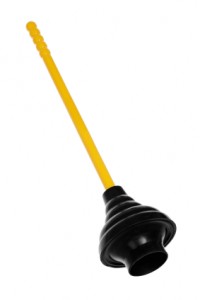It’s your big holiday party. The carols are playing, the champagne is sparkling, and everyone’s having a great time. But when you step into the bathroom to wash your hands, you discover that one of your wonderful in-laws has attempted to flush the equivalent of a small forest down your toilet. You have a houseful of people and you need to unclog your toilet now. What can you do?
To really handle this situation well, you should stock up on the right tools ahead of time. Along with the veggie dip and spiced wine, add the following to your holiday shopping list: a flange or ball plunger, and a toilet auger (also known as a closet auger). You should be able to get both in your local hardware store.
But wait! you say. I already have a plunger! You probably do, but it may be the wrong kind. The standard “cup plunger” (which is what most people have on hand) looks like a rubber ball cut in half. Contrary to what most people think, these plungers aren’t for toilets – they are for the tub, where the flat edge of the plunger will connect well with the flat bottom of the tub to form a vacuum seal. The right tool for unclogging your toilet is a flange plunger or a ball plunger. These are properly shaped to connect to the curved shape of a toilet bowl and maintain a good vacuum seal while you plunge.
So…back to the party and your emergency. Assuming that you’ve prepared appropriately, you will probably be able to clear that clog quite easily – and if you’re discreet, your party guests will never need to know! The most important thing is to overcome the temptation to flush an already blocked-up toilet (we know, maybe you’ll get lucky, but more likely, you’ll end up overflowing the bowl and making a really disgusting mess and having to clean it up with the guest towels). Instead, start by plunging with your handy-dandy new flange plunger. Gently push the plunger head through the water, allowing the air to escape from it. Then, fit the plunger around the hole in the bottom of the bowl, and push the handle up and down rapidly until you feel the clog release or until the water level in the toilet drops.
Now, test to see if the toilet really is draining. Once again, it’s tempting to flush – but don’t do it. Instead, pour a little water down the toilet from a bucket, or lift the tank cover and slowly lift the flapper seal at the bottom to allow a little water to enter the bowl. (Don’t lift the flapper all the way, or the toilet will flush, and you might end up wading around in something you’d rather not think about.)
If the added water leaves the toilet easily, then the clog is cleared. If not, plunge again.
If the clog won’t clear after repeated plunging, break out the heavy firepower in your freshly-stocked plumbing arsenal. Your new toilet auger has an auger bit (a sharp spiral of wire) at the end that is connected to semi-rigid wire or cable that flexes to thread through the bends in a toilet bowl. The auger bit and the wire are connected in turn to a long handle with a hand crank that you can turn to work your way through the clog.
Start by turning off the water supply to your toilet, to keep any possible mess to a minimum. Then, fully retract the auger cable into the handle and put the auger into the toilet so that the curved bit where the cable comes out of the handle faces the same way the toilet drains. (Some toilets drain to the front and others to the rear – look into the toilet bowl to see which way yours goes.) Work the cable into the drain with a combination of cranking and gentle pressure until it becomes tight and stops turning, or until you feel resistance. Either one probably means that you’ve hit the clog. Crank the auger quickly to break up the clog, and if you can’t crank any more, stop and start cranking in the reverse direction. Continue doing this until you’ve inserted the auger all the way. If you feel that the auger has grabbed something and is stuck, push and pull gently or crank back and forth while gently pulling up. Never force the auger or you may break the toilet porcelain.
After breaking up the clog, use the plunger again to move the obstruction down the drain line. Then, check to make sure the toilet is draining (remember – do this by adding a small amount of water from a bucket or by lifting the flapper slightly, not by flushing!). If and only if the toilet seems to be draining well, try flushing it. If it flushes, you’ve defeated the clog, and you can turn the water supply to your toilet back on.
Then, don’t forget to clean the auger! Put it in a garbage bag to prevent drips and carry it out of the house. (Okay, you don’t have to do this during your holiday party, but please don’t forget to do it later!) Clean it outside and then bring it to a warm dry place to dry. Spray the auger cable with WD-40 to remove any remaining moisture and protect it while in storage. Don’t store the auger lying down – hang it, handle side up, from a hook in your workshop or shed.
Toilet augers have a reach of about three feet. If your clog doesn’t clear after you’ve tried the auger, it probably means that the obstruction is farther down the drain line. However, don’t try using a drain snake to clear the blockage, because it can damage your toilet.
Instead, call us at Carney: 215-346-7160. Even over the holidays, we’re available 24/7 to help you cope with emergencies. We’ll be glad to fix the problem and get you back to your party.
Continue Reading


